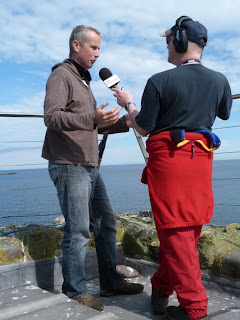 |
| Pufflings already heading out to the open sea |
 |
| Sandwich Terns getting itchy feet and preparing to leave |
 |
| Arctic Tern chicks get their last feed before heading down to the other end of the planet! |
Tuesday 31st July comments: It’s still all go on the islands, with the remaining
breeding birds giving that one final push to get their chicks ready for their
first flight. The birds on the Farnes have an epic journey ahead of them, with
many of them covering thousands of miles, over turbulent seas and through
stormy skies.
The Guillemots and Razorbills that have spent the past few
months clinging to the cliff faces are now well on their way out to their
favourite wintering spots in offshore waters of the North Sea, the chicks now
able to fend for themselves and feeding off the local catch! The Puffins,
already off the islands and in the water, will similarly soon be heading out
into the open ocean, some even heading around the north of Scotland into the north
Atlantic.
But our hardest-going fliers have to be our terns. Our
Sandwich Terns are getting restless, flying back and forth over the island with
their chicks closely following, and they’ll soon be heading down to west Africa
to spend our winter in the warmth! Our Arctic Terns, however, will be heading
even further down the west coast of Africa all the way to Antarctica, chasing
the eternal sun to spend the southern summer down in the rich Southern Ocean. This includes our chicks, hatched only a
month and a half ago, who will be learning the route en-route from their knowledgeable parents.
And then in 8 months time, they’ll all be back again to try
once more out on these productive islands. It really is an amazing feat of nature, and
one that we, and you, can enjoy every year on Planet Farne!


































